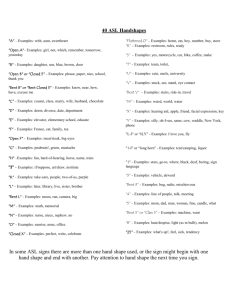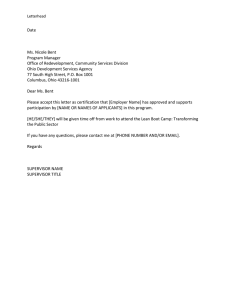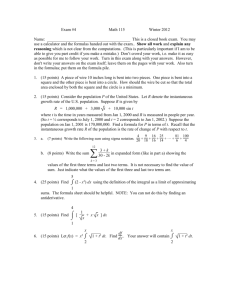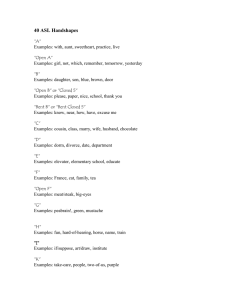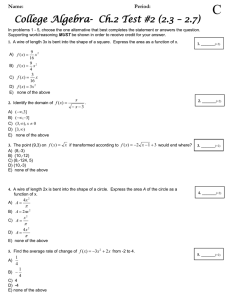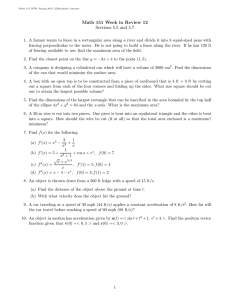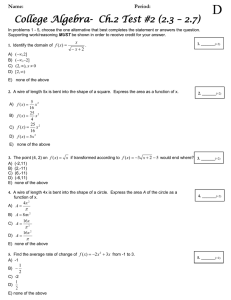When a Boolean Function can be Expressed as the Sum of two Bent
advertisement
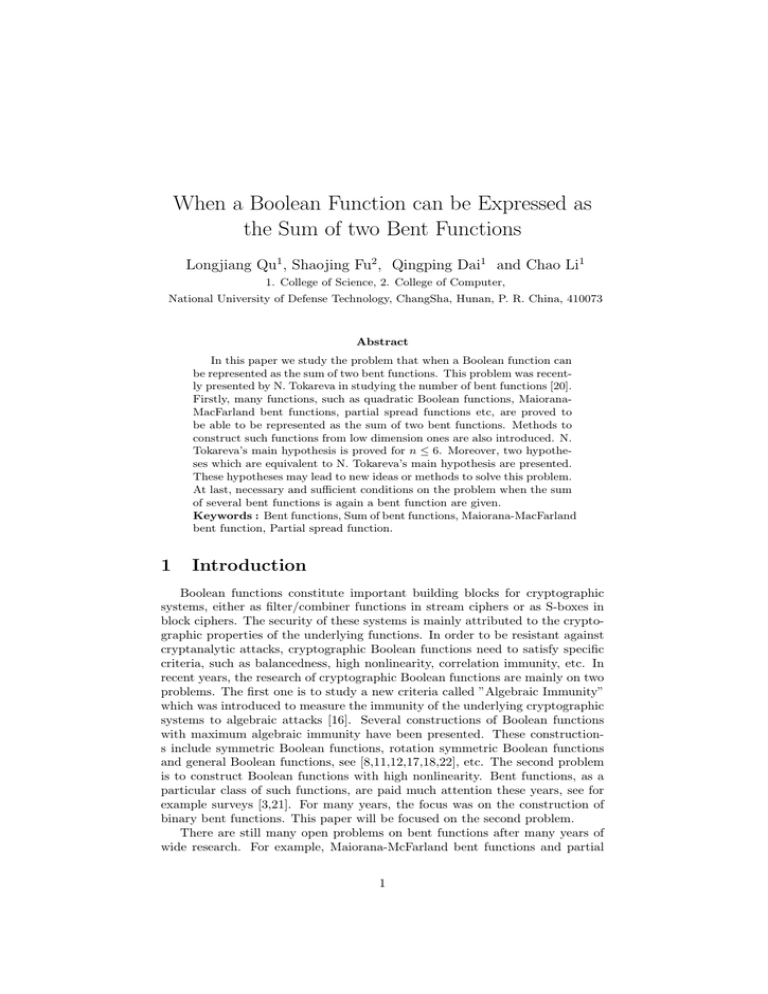
When a Boolean Function can be Expressed as
the Sum of two Bent Functions
Longjiang Qu1 , Shaojing Fu2 , Qingping Dai1 and Chao Li1
1. College of Science, 2. College of Computer,
National University of Defense Technology, ChangSha, Hunan, P. R. China, 410073
Abstract
In this paper we study the problem that when a Boolean function can
be represented as the sum of two bent functions. This problem was recently presented by N. Tokareva in studying the number of bent functions [20].
Firstly, many functions, such as quadratic Boolean functions, MaioranaMacFarland bent functions, partial spread functions etc, are proved to
be able to be represented as the sum of two bent functions. Methods to
construct such functions from low dimension ones are also introduced. N.
Tokareva’s main hypothesis is proved for n ≤ 6. Moreover, two hypotheses which are equivalent to N. Tokareva’s main hypothesis are presented.
These hypotheses may lead to new ideas or methods to solve this problem.
At last, necessary and sufficient conditions on the problem when the sum
of several bent functions is again a bent function are given.
Keywords : Bent functions, Sum of bent functions, Maiorana-MacFarland
bent function, Partial spread function.
1
Introduction
Boolean functions constitute important building blocks for cryptographic
systems, either as filter/combiner functions in stream ciphers or as S-boxes in
block ciphers. The security of these systems is mainly attributed to the cryptographic properties of the underlying functions. In order to be resistant against
cryptanalytic attacks, cryptographic Boolean functions need to satisfy specific
criteria, such as balancedness, high nonlinearity, correlation immunity, etc. In
recent years, the research of cryptographic Boolean functions are mainly on two
problems. The first one is to study a new criteria called ”Algebraic Immunity”
which was introduced to measure the immunity of the underlying cryptographic
systems to algebraic attacks [16]. Several constructions of Boolean functions
with maximum algebraic immunity have been presented. These constructions include symmetric Boolean functions, rotation symmetric Boolean functions
and general Boolean functions, see [8,11,12,17,18,22], etc. The second problem
is to construct Boolean functions with high nonlinearity. Bent functions, as a
particular class of such functions, are paid much attention these years, see for
example surveys [3,21]. For many years, the focus was on the construction of
binary bent functions. This paper will be focused on the second problem.
There are still many open problems on bent functions after many years of
wide research. For example, Maiorana-McFarland bent functions and partial
1
spread bent functions are the two largest classes of bent functions that are now
known to us. However, they occupy only a negligible part of all bent functions
with n ≥ 8 variables [15]. Further, the number of bent functions in n variables
is still unknown if n > 8. Moreover, there is a large gap between existing lower
n
n−1
1
n/2
(2n/2 )!22
and upper 22 + 2 (n/2) bounds for this number. There are several
improvements of these bounds, see [1] and [6], but not too significant. To find
the asymptotic value for the number of all bent functions is a long-standing
hard problem closely connected to the problem of enumeration of Hadamard
matrices.
Recently, N. Tokareva presented a new way to study the number of bent
functions [20]. The idea is to study lower bounds on the number of bent functions
given by iterative constructions. Evaluation of this lower bound was then shown
to be closely connected to the problem of decomposing a Boolean function into
the sum of two bent functions. About this problem, N. Tokareva raised the
following main hypothesis [20].
Hypothesis 1.1 [20] Let n be an even positive integer. Then any Boolean
function in n variables with degree ≤ n2 can be expressed as the sum of two bent
functions.
If the above hypothesis can be proved, then one can get a best asymptotn
n−c
ic value of the number of all n-variable bent functions, 22 +d(n/2) for some
constants c, d with 1 ≤ c ≤ 2 [20]. Hypothesis 1.1 was verified to be true via
computer search for n ≤ 6 in [20]. However, until now neither a proof nor an
counterexample of this hypothesis is found yet.
In this paper it is studied the problem when a Boolean function can be expressed as the sum of two bent functions. Many functions, such as quadratic
Boolean functions, Maiorana-MacFarland bent functions, partial spread functions etc, are proved to be such functions. We also provide a proof of Hypothesis
1.1 for n ≤ 6. Moreover, two hypotheses which are equivalent to Hypothesesis
1.1 are presented. These hypotheses may lead to new methods to solve this
problem. At last, necessary and sufficient conditions on the problem when the
sum of several bent functions is again a bent function are given.
The rest of the paper is organized as follows. Some preliminaries of bent
functions are introduced in Section 2. In section 3, several classes of functions
are proved to be able to be expressed as the sum of two bent functions, and
two hypotheses equivalent to Hypothesis 1.1 are also introduced. In Section
4, methods to construct such functions from low dimension ones are given. A
proof of Hypothesis 1.1 for n ≤ 6 is given in Section 5. In Section 6 some results
on the problem when the sum of several bent functions is still a bent function
are presented. Section 7 concludes the paper.
2
Preliminaries
Let F2 be the binary finite field, and the vector space of dimension n over
F2 is denoted by Fn2 . By a little abuse of notation, we still use + to denote the
addition in F2 and Fn2 . An n-variable Boolean function is a mapping from Fn2
to F2 . The set of all n-variable Boolean functions is denoted by Bn . For any
2
f ∈ Bn , f can be uniquely represented as
∑
f (X) = f (x1 , · · · , xn ) =
I⊆{1,···,n}
aI
∏
xi , aI ∈ F2 ,
(1)
i∈I
which is called the algebraic normal form(ANF) of f . The algebraic degree of
f ̸= 0, denoted by deg(f ), is the maximum degree of the monomials in (1)
whose coefficients are nonzero. All the Boolean functions with algebraic degree
no more than 1 are called affine functions, and we use An to denote all the affine
functions with n variables.
The set supp(f ) is the subset of Fn2 where f takes the value 1. The Hamming
weight of f is wt(f ) = |supp(f )|. A Boolean function f ∈ Bn is called balanced
if wt(f ) = 2n−1 . If f ∈ Bn is balanced, then deg(f ) ≤ n − 1. For f, g ∈ Bn ,
the Hamming distance between f and g is given by d(f, g) = wt(f + g). The
nonlinearity of f , denoted by nlf , is the minimum Hamming distance between f
and An . The Walsh transform of f is a real-valued
function on Fn2 , whose value
∑
n
f (x)+ω·x
at point ω ∈ F2 is defined as: Wf (ω) =
(−1)
. It is well-known that
x∈Fn
2
1
max{|Wf (ω)| : ω ∈ Fn2 } ≤ 2n−1 − 2n/2−1 .
2
If the above equality holds, then f is called a bent function. Bent functions
with n variables exist if and only if n is even. Denote by BTn the set of all
bent functions with n variables. It is known that if f ∈ BTn and n ≥ 4, then
deg f ≤ n2 . If f ∈ BT2 , then deg f = 2.
Vectorial Boolean functions are the mappings from Fn2 to Fm
2 , and such a
function is called an (n, m) function. For an (n, m) function F = (f1 , · · ·, fm ), fi
is called its i-th coordinate function, the linear combinations, with non all-zero
coefficients, of the coordinate functions of F are called its component functions.
An (n, m) function F is called a vectorial bent function if all of its component
functions are bent Boolean functions.
From now on, we always let n = 2k be an even integer. Moreover, we assume
that n ≥ 4 such that any n-variable bent function have algebraic degree ≤ k.
nlf = 2n−1 −
3
Several classes of functions in Xn
Let us first introduce some notations in [20]. Define the following set Xn =
{f + g|f, g ∈ BTn } and consider the system {Cf |f ∈ BTn } of its subsets defined
as Cf = f + BTn . So one can get Xn = ∪f ∈BTn Cf . Let ψ be an element of Xn .
The number of subsets C
f that cover ψ we call multiplicity of ψ and denote it
∑
by m(ψ). Then we have ψ∈Xn m(ψ) = |BTn |2 . It is clear that for any l ∈ An ,
we have l ∈ Xn and m(l) = |BTn |. It is also clear that for any ψ ∈ Bn , l ∈ An ,
ψ ∈ Xn holds if and only if ψ +l ∈ Xn holds. Further, if ψ ∈ Xn , then m(ψ) ≡ 0
mod 2n+1 , and m(ψ) = m(ψ + l) holds for any l ∈ An . More generally, we have
Lemma 3.1 Xn and m(ψ) are invariant under the action of general affine
group and the addition of affine functions.
If we assume that all the functions of both Xn and BTn are free of affine
terms, then we have
)2
(
|BTn |
|Xn |
≥ n+1 .
2n+1
2
3
Thus we get the following result, which is a slight improvement of Proposition
3 of [20].
Proposition 3.2 |BTn |2 ≥ 2n+1 |Xn | for any even n ≥ 2.
Proposition 3.2 provides a new way to lower bound the number of all nvariable bent functions [20]. If Hypothesis 1.1 is true, then instantly one can get
n
n+1
n−2
1
|BTn | ≥ 22 + 4 (n/2)+ 2 , which will be the best lower bound of this number.
It should be noted that even if Hypothesis 1.1 does not hold, it is also quite
interesting to study the asymptotic value of Xn since it may lead to a bound
better than all existing results. Moreover, the research of the properties of Xn
may also be helpful to the research of the properties of bent functions.
Now we introduce the first several classes of functions in Xn .
Theorem 3.3 Let ψ ∈ Bn with deg ψ ≤
n
2
= k.
1. If deg ψ = 2, then ψ ∈ Xn ;
2. If ψ = (x · π1 (y) + g1 (y)) + (z · π2 (w) + g2 (w)), where x, y, z, w ∈ Fk2 such
that every element of Fn2 can be uniquely expressed as (x, y) and also be
uniquely expressed as (z, w), both π1 and π2 are permutations of Fk2 , g1 , g2
be any two Boolean functions with k variables. Then ψ ∈ Xn .
3. If ψ(x, y) = x · π(y) + g(y), where x, y ∈ Fk2 , π(y) = π1 (y) + π2 (y), both π1
and π2 are permutations of Fk2 , g be any Boolean function with k variables.
k
Then ψ ∈ Xn and m(ψ) ≥ 22 .
4. If ψ(x, y) = (x · π1 (y) + y · π2 (x)) + g1 (y) + g2 (x), where x, y ∈ Fk2 , both π1
and π2 are permutations of Fk2 , g1 , g2 be any two Boolean functions with
k variables. Then ψ ∈ Xn . In particular, if ψ(x, y) = g1 (y) + g2 (x), then
ψ ∈ Xn .
Proof. 1. By Lemma 3.1, we only need to prove that for any 1 ≤ r ≤ k,
r
∑
fr (x1 , x2 , · · · , xn ) =
x2i−1 x2i ∈ Xn . Note that k ≥ 2 since n ≥ 4. It is well
i=1
known that a quadratic Boolean function with n variables is bent if and only if
it is nonsingular.
For any 1 ≤ r ≤ k, and any 1 ≤ i ≤ 2r, let
if i is odd;
xi ,
r−i/2
∑
yi =
xi+2j , if i is even.
j=0
Let gr (x1 , x2 , · · · , xn ) =
let hr (x1 , x2 , · · · , xn ) =
r−1
∑
y2i−1 y2i + x2r−1 (x2r + x2 ) +
i=1
r−1
∑
y2i−1 y2i+2 + x2r−1 x2 +
i=1
k
∑
k
∑
x2i−1 x2i , and
i=r+1
x2i−1 x2i . It is easy to
i=r+1
verify that fr = gr + hr , and that both gr and hr are nonsingular quadratic
Boolean functions. Hence fr can be expressed as the sum of two quadratic bent
functions. We proved the first part.
2. Let f1 (x, y) = x · π1 (y) + g1 (y), f2 (z, w) = z · π2 (w) + g2 (w) be two
Maiorana-McFarland Bent functions. Then ψ = f1 + f2 . Thus ψ ∈ Xn .
4
3. In the second part, let z = x, w = y and g(y) = g1 (y) + g2 (y), then we
k
know ψ ∈ Xn . It is easy to see that m(ψ) ≥ 22 .
4. In the second part, let z = y and w = x, then we know ψ ∈ Xn . Further,
let π1 = π2 , we have ψ(x, y) = g1 (y) + g2 (x) ∈ Xn .
The first part of the above theorem tells us that any quadratic Boolean
function with n ≥ 4 variables can be expressed as the sum of two bent functions.
The following corollary follows from the third part of the above theorem.
Corollary 3.4 Let ψ ∈ Bn . If ψ can be expressed as a Boolean function with
k
at most k = n2 variables, then ψ ∈ Xn and m(ψ) ≥ (2k )!22 . In particular, if
ψ = x1 x2 · · · xr , where r is an integer such that 1 ≤ r ≤ k, then ψ ∈ Xn .
Proof. In the third part of Theorem 3.3, let π1 = π2 be any permutation
on Fk2 , the result of this corollary thus follows.
It is clear that the set of all monomials with algebraic degree ≤ k is a basis
of the vector space of the Boolean functions with algebraic degree ≤ k. Thus
it follows directly from Corollary 3.4 that the following hypothesis is equivalent
to Hypothesis 1.1.
Hypothesis 3.5 Let n ≥ 4 be an even integer. Then Xn is closed with respect
to addition, that is, if f, g ∈ Xn , then f + g ∈ Xn .
Let f, g ∈ Xn , then there exist n-variable bent functions f1 , f2 , g1 , g2 such
that f = f1 + f2 and g = g1 + g2 . To prove that f + g ∈ Xn , we need to find two
n-variable bent functions h1 , h2 such that f + g = f1 + f2 + g1 + g2 = h1 + h2 .
Thus it follows that Hypothesis 3.5 holds if and only if the sum of any four
bent functions in n variables can be expressed as the sum of two bent functions
with the same variables. Further, the number of bent functions involved can be
reduced.
Hypothesis 3.6 Let n ≥ 4 be even. Then the sum of any three bent functions
in n variables can be expressed as the sum of two bent functions with the same
variables.
Proposition 3.7 Hypothesis 1.1, Hypothesis 3.5 and Hypothesis 3.6 are all equivalent. Any one holds if and only if the other two hold.
Proof. We have already known that Hypothesis 1.1 and Hypothesis 3.5 are
equivalent. Now we prove that Hypothesis 3.6 is also equivalent to Hypothesis
1.1. First, Hypothesis 3.6 can be deduced from Hypothesis 1.1 since the sum of
three bent functions has algebraic degree ≤ k. Second, assume that Hypothesis
3.6 holds. Then it follows that the sum of any four bent functions in n variables
can be expressed as the sum of two bent functions with the same variables. Thus
Hypothesis 3.6 implies Hypothesis 3.5, and hence Hypothesis 1.1. The proof is
now completed.
Though both Hypothesis 3.5 and Hypothesis 3.6 are equivalent to Hypothesis
1.1, they provide us different sides of the same problem. We hope that these
new hypotheses can lead to new ideas or methods to solve the problem.
Let f = g1 + g2 + g3 , where f ∈ Bn and g1 , g2 , g3 ∈ BTn . Assume there
exists h1 , h2 ∈ BTn such that f = g1 + g2 + g3 = h1 + h2 . Then we have
h2 = g1 + g2 + g3 + h1 . Thus it is equivalent to find h1 ∈ Bn such that both h1
5
and g1 + g2 + g3 + h1 are bent. Hence Hypothesis 3.6 is related to the following
questions: When the sum of four bent functions is a bent function again? When
the sum of two bent functions is a bent function again? Some results on these
two questions will be presented in Section 6.
Let k be a positive integer, and let
Sk = {f : Fk2 −→ Fk2 |f = π1 + π2 , both π1 and π2 are permutations on Fk2 }.
(2)
According to Theorem 3.3(3), we want to investigate the set Sk for any
positive integer k. First, we recall a result by M. Hall, Jr. in 1952.
Theorem 3.8 [13] Let G = {a1 , · · · , an } be an abelian additive group with
order n, and let b1 , · · · , bn ∈ G. Then there exists a permutation π of {1, · · · , n}
n
∑
such that {a1 + bπ(1) , · · · , an + bπ(n) } = G if and only if
bi = 0.
i=1
Let f : Fk2 −→ Fk2 . Then f ∈ Sk if and only if there exist two permutations
π1 and π2 on Fk2 such that π2 = π1 + f . Hence the following result follows from
Theorem 3.8.
Theorem 3.9 ∑
Let k be a positive integer, and let f : Fk2 −→ Fk2 . Then f ∈ Sk
if and only if
f (x) = 0, where Sk is defined in (2).
x∈Fk
2
Now all the elements of Sk are determined by the above theorem. Particularly, we know that all permutations of Fk2 are in Sk , which implies the following
result.
Theorem 3.10 Let ψ be a Maiorana-McFarland bent function with n ≥ 4 variables. Then ψ ∈ Xn .
We have seen that all Maiorana-McFarland bent functions are in Xn . Now we
turn to the other widely known bent class–partial spread bent function. Recall
that a partial spread of order m(an m-spread) in Fn2 is a set of k-dimensional
subspaces H1 , · · · , Hm of Fn2 such that Hi ∩Hj = {0} holds for all 1 ≤ i < j ≤ m.
Clearly, the order of a partial spread is less than or equal to 2k + 1, and such a
maximal partial spread is called a spread. Let {H1 , · · · , Hm } be an m-spread.
Let fi : Fn2 → F2 be ∑
the indicator function of Hi , i.e. fi−1 (1) = Hi . The
m
Boolean function f = i=1 fi is called a partial spread function of order m or
an m-spread function. The partial spread functions of order 2k−1 or 2k−1 + 1
consists of the class of partial spread bent functions [10].
Theorem 3.11 Let ψ ∈ Bn be a partial spread function of order t, 1 ≤ t ≤
2k + 1. Then ψ ∈ Xn . In particular, all partial spread bent functions are in Xn .
Proof. Without loss of generality, we can assume that E1 , E2 , · · · , E2k +1 is a
spread of Fn2 and ψ equals the sums (modulo 2) of the indicators of subspaces
E1 , E2 , · · · , Et . Let a0 , b0 ∈ {0, 1} and satisfying a0 + b0 ≡ t mod 2, and let
k
a = t+a02−b0 and s = 2 +a02+b0 −t . Then a + s = 2k−1 + a0 and t − a + s =
2k−1 + b0 . Let f be an n-variable Boolean function such that f equals the sums
(modulo 2) of the indicators of a subspaces of E1 , E2 , · · · , Et and s subspaces
of Et+1 , Et+2 , · · · , E2k +1 , and let h = f + ψ. Then it is easy to verify that both
f and h are partial spread bent functions. We are done.
6
Two classes of bent functions have been derived in [4] from MaioranaMcFarland class, by adding to some functions of this class the indicators of some
vector spaces. The first class, denoted by Class D, is the set of the functions of
n/2
the form f (x, y) = x · π(y) + 1E1 (x)1E2 (y), where π is any permutation on F2
n/2
and where E1 , E2 are two linear subspaces of F2 such that π(E2 ) = E1⊥ (1E1
and 1E2 denote their indicators). The second class, denoted by Class C, is the
set of the functions of the form f (x, y) = x · π(y) + 1L (x), where π is any pern/2
mutation on F2 and L is any linear subspace such that for any element a of
n/2
F2 , the set π −1 (a + L⊥ ) is a flat. Thus we have the following proposition:
Proposition 3.12 Let ψ ∈ Bn . If ψ can be expressed as the sum of two functions from the union of the sets Class D and Class C bent functions, then
ψ ∈ Xn .
The functions in the above proposition do not have an explicit form or an
explicit structure as those in the former theorems or propositions do. The
reason is the restrictions needed in constructing Class D and Class C bent
functions. Indeed, more restrictions on constructing bent functions will lead to
more complicated structure of the corresponding sum set. There are several
quite general constructions, such as Generalized Partial Spread Class in [5] or
a general class of Maiorana-McFarland’s construction in [7], etc. However, if
we use such bent functions to construct elements of Xn , we can only get some
results similar with Proposition 3.12, which provide functions with no explicit
forms. We do not introduce these results here since it may be more interesting
to construct the functions of Xn with explicit forms.
4
Constructing new functions from those with
lower dimension
In last section several classes of functions of Xn are presented. Those are
mainly coming from existing constructions of bent functions, more precisely,
from the primary constructions of bent functions. There are also some secondary
constructions of bent functions, which means recursive constructions. From
direct sum and indirect sum constructions of bent functions([9, Proposition
3.2]), we can have the following result.
Theorem 4.1 Let n and m be two positive even integers, and let f (x) and g(y)
be any functions of Xn and Xm respectively. Then f (x) + g(y) ∈ Xn+m and
f (x)g(y) ∈ Xn+m .
Proof. Let f (x) = f1 (x)+f2 (x), g(y) = g1 (y)+g2 (y), where f1 (x), f2 (x) ∈ BTn ,
g1 (y), g2 (y) ∈ BTm . Then by the well-known direct sum construction of bent
functions, both h1 (x, y) = f1 (x) + g1 (y) and h2 (x, y) = f2 (x) + g2 (y) are bent
functions with n + m variables. Thus f (x) + g(y) = f1 (x) + g1 (y) + f2 (x) +
g2 (y) ∈ Xn+m . Moreover, by the so-called indirect sum construction of bent
functions([9, Proposition 3.2]), we have
h(x, y) = f1 (x) + g1 (y) + (f1 (x) + f2 (x))(g1 (y) + g2 (y))
= h1 (x, y) + f (x)g(y) ∈ BTn+m .
7
Hence f (x)g(y) = h1 (x, y) + h(x, y) ∈ Xn+m .
Theorem 4.1 can help us to build many functions of Xn from those with
lower dimensions. With this result, we can get more functions that can not be
obtained before.
Example 4.2 Let n and m be two positive even integers.
(1) Let f (x1 , · · · , xn ) = f1 (x1 , · · · , x n2 ), and for integer 1 ≤ r ≤ m
2 , let
r
r
∑
∑
gr (xn+1 , · · · , xn+m ) =
xn+2i−1 xn+2i . Then both f1 (x1 , · · · , x n2 )+ xn+2i−1 xn+2i
i=1
and f1 (x1 , · · · , x n2 ) · (
r
∑
i=1
xn+2i−1 xn+2i ) are in Xn+m .
i=1
n
n
(2) Let f (x, y) = x · π(y) + g(y), where x, y ∈ F22 , π is a permutation of F22 ,
g ∈ B n2 , and let h(z1 , · · · , zm ) = h1 (z1 , · · · , z m2 ). Then both f (x, y) + h(z) and
f (x, y)h(z) are in Xn+m .
The following result is a link with vectorial bent functions.
Proposition 4.3 Let r ≤ n2 be a positive integer, and let F = (f1 , · · · , fr ) be
an (n, r)-bent function. Then all the component functions of F are in Xn .
Proof. Let ψ =
r
∑
ci fi = c · F be a component function of F , where 0 ̸= c =
i=1
(c1 , · · · , cr ) ∈ Fr2 . Then there exists d ̸= 0, c such that ψ = d · F + (c + d) · F .
Hence ψ ∈ Xn . From Proposition 4.3, we know that any construction of vectorial bent functions can provide a set of elements of Xn . All the known primary and secondary
constructions of vectorial bent functions were surveyed and studied by Carlet in
2010 [9]. The component functions of all these primary constructions belongs,
up to affine equivalence, to the Maiorana-MacFarland class of Boolean bent
functions or Partial Spread constructions or power functions. All the existing
secondary constructions of vectorial bent functions are either direct sum constructions or indirect sum constructions. Thus we can hardly get new elements
of Xn from existing constructions of vectorial bent functions.
5
Proof of Hypothesis 1.1 for n ≤ 6
Hypothesis 1.1 have been verified via exhaust research in [20] for n ≤ 6. In
this section we present a proof of Hypothesis 1.1 for all n ≤ 6. The case for n = 2
is quite trivial. If n = 4, then it follows from Theorem 3.3(1) that X4 consists
of all Boolean functions of degree not more than 2. Now we assume n = 6. It
is known that there are 34 affine equivalent classes of RM (3, 6)/RM (1, 6) [14].
By Lemma 3.1, to verify Hypothesis 1.1, we only need to prove that all these
representatives are in X6 . We give these results in Table 1. The follows are the
comments of the table.
1. The representatives of all the equivalent classes of RM (3, 6)/RM (2, 6) and
those of RM (3, 6)/RM (1, 6) have been listed in Table B.1 and Table D.1
of [2].
2. To simplify notation, as in [2], we use 123 to denote x1 x2 x3 and 1· (23+3)
to denote x1 · (x2 x3 + x3 ), and so on.
8
Table 1: Proof of Hypothesis 1.1 for n = 6
Class
Representative of
f1
RM (3, 6)/RM (2, 6)
0
f2
123
f3
123+245
f4
123+456
Representative of
RM (3, 6)/RM (1, 6)
0
12
14+23
16+25+34
0
14
24+15
16+25+34
45
16+45
0
13
14
16
26
26+13
26+14
13+15+26+34
34+13+15
34+16
0
14
15+24
34+25+16
f5
123+245+346
0
12+13
15
12+13+25
14+25
35+26+25+12
+13+14
25+15+16
f6
123+145+246
+356+456
0
12+13
23+15+14
9
Proofs
Theorem 3.3 (1)
Corollary 3.4
1·(23+4)
1·(23+5)+4 ·2
Proposition 3.10
1·(23)+4 ·5
2·(13)+5·4+6·1
1·(23)+5 ·(24)
1·(23+3)+5 ·(24)
1·(23+4)+5 ·(24)
3·(12)+5 ·(24)+6 ·(1)
1·(23)+5 ·(24)+6 ·(2)
1·(23+3)+5 ·(24)+6 ·(2)
1·(23+4)+5 ·(24)+6 ·(2)
Proposition 3.10
1·(23+3+5)+4 ·(25 + 3)
3·(12+4)+5 ·(24)+6 ·(1)
Theorem 3.3(4)
2·(13+4)+5 ·(1)+6 ·(3)+(14);
4·(56+2)+1 ·(5)+3 ·(6)
1·(23+4)+5 ·(2)+6 ·(3)+(24);
1·(4+5)+2 ·(5)+6 ·(45 + 3)
2·(13+4)+5 ·(1)+6 ·(3)+(34);
4·(56+2)+1 ·(5 + 6)+3 ·(6)+(25)
1·(23)+5 ·(24)+6 ·(34)
1·(23+2+3)+5 ·(24)+6 ·(34)
2·(45+6)+3 ·(46 + 5 + 6)+1 ·(4);
2·(13+6)+4 ·(1)+5 ·(3 + 1) + (36)
1·(23+2+3)+5 ·(24 + 2)+6 ·(34)
1·(23+4)+5 ·(24 + 2)+6 ·(34)
Proposition 3.10
2·(45+5+6)+3 ·(46 + 5)+1 ·(4);
2·(13+6)+4 ·(1)+5 ·(3 + 1) + (16)
1·(23+3+4)+6 ·(24 + 3)+5 ·(2);
1·(45+3+4)+6 ·(35 + 45 + 3)+2 ·(5)
1·(23+2+3+6)+5 ·(36 + 2)+4 ·(3) + (26);
1·(45+6)+2 ·(46 + 5 + 6)+3 ·(4) + (456)
1·(23+6)+5 ·(36 + 2 + 6)+4·(3) + (23);
1·(45+4+5+6)+2·(46 + 5)+3·(4) + (456 + 56)
3. The proofs for the representative functions to be in X6 are listed in the
last column of the table. All of them are the results in the former sections,
such as Theorems 3.3, Proposition 3.10 etc. Proposition 3.10 is shown as
a proof for some functions since those are bent functions and the widely
known fact that any bent function with 6 variables is affine equivalent to
a Maiorana-MacFarland bent function.
Thanks to the existing affine equivalent classes of RM (3, 6)/RM (1, 6), we
can give a proof of Hypothesis 1.1 for n = 6. This reverified N. Tokareva’s
computer search result, which lasted 14 days by using processor Intel Core i7
3.0 Ghz 256 Gb, and running with full loading of RAM [20]. However, our
proofs can be easily checked and save much time.
6
When the sum of several bent functions is again a bent function?
As pointed out in Section 3, Hypothesis 3.6 is related to the following questions: When the sum of four bent functions is again a bent function? When
the sum of two bent functions is again a bent function? Here we present some
necessary and sufficient conditions on these questions. The following lemma is
quite well known, see for example [3].
n
Lemma 6.1 Let f ∈ Bn , then f is a bent function if and only if Wf (α) ≡ 2 2
n
mod 2 2 +1 holds for any α ∈ Fn2 .
∑
∑4
4
4
Let f1 , f2 , f3 , f4 ∈ Bn , and let s41 =
1≤i<j≤4 fi fj , s3 =
i=1 fi , s2 =
∏
∑4 ∏
4
4
j=1 fj . Then it is easy to check the following equalii=1
j̸=i fj , s4 =
ty(Note that the sums being computed in Z and not modulo 2):
f1 + f2 + f3 + f4 = s41 + 2s42 + 4s44 .
Proposition 6.2 Let f1 , f2 , f3 , f4 ∈ BTn , and let s41 , s42 , s43 , s44 be defined as
n
n
above. Then s41 ∈ BTn if and only if Ws42 (α) + 2Ws44 (α) ≡ 2 2 −1 mod 2 2
holds for any α ∈ Fn2 . In particular, if s44 ≡ 0, then s41 ∈ BTn if and only if
n
n
Ws42 (α) ≡ 2 2 −1 mod 2 2 holds for any α ∈ Fn2 .
Proof. Let α ∈ Fn2 . Then
Wf1 (α) + Wf2 (α) + Wf3 (α) + Wf4 (α)
∑
=
(−1)α·x [(1 − 2f1 (x)) + · · · + (1 − 2f4 (x))]
x∈Fn
2
=
∑
(−1)α·x [4 − 2(s41 (x) + 2s42 (x) + 4s44 (x))]
x∈Fn
2
= Ws41 (α) + 2Ws42 (α) + 4Ws44 (α) − 3
∑
(−1)α·x
x∈Fn
2
= Ws41 (α) + 2Ws42 (α) + 4Ws44 (α) − 3 · 2n δ0 (α),
where δ0 denotes the Dirac symbol, that is, defined by δ0 (α) = 1 if α = 0 and
δ0 (α) = 0 otherwise. Since f1 , f2 , f3 , f4 ∈ BTn , we have Wf1 (α) + Wf2 (α) +
10
n
Wf3 (α) + Wf4 (α) ≡ 0 mod 2 2 +1 for any α ∈ Fn2 . Thus Ws41 (α) + 2Ws42 (α) +
n
4Ws44 (α) ≡ 0 mod 2 2 +1 holds for any α ∈ Fn2 . Therefore, s41 is bent if and
n
n
only if Ws41 (α) ≡ 2 2 mod 2 2 +1 holds for any α ∈ Fn2 , if and only if Ws42 (α) +
n
n
2Ws44 (α) ≡ 2 2 −1 mod 2 2 holds for any α ∈ Fn2 . The second argument follows
similarly. Similarly, we can get the following result on the problem when the sum of
two bent functions is again a bent function.
Proposition 6.3 Let f1 , f2 ∈ BTn . Then f1 +f2 ∈ BTn if and only if Wf1 f2 (α) ≡
n
n
2 2 −1 mod 2 2 holds for any α ∈ Fn2 .
7
Conclusion
This paper studies on the problem when a Boolean function can be expressed
as the sum of two bent functions. Many functions are proved to be able to
be represented as the sum of two bent functions. Two hypotheses which are
equivalent to Hypotheses 1.1 are presented. We hope that these hypotheses
can lead to new ideas or methods to study this problem. At last, to find new
constructions of large classes of bent functions with ”simple” forms other than
Maiorana-MacFarland class and partial spread class are quite important to the
research of bent functions and this problem.
Acknowledgments
The authors would like to thank Prof. Qing Xiang for bringing Theorem 3.8
to their attention, which leads directly to Theorem 3.9. This work is supported
by the National Natural Science Foundation of China (No: 61103191, 61272484).
References
[1] S. Agievich, On the representation of bent functions by bent rectangles,
In Proc. of probabilistic methods in discrete mathematics, 121-135, 2000.
[2] A. Braeken, Cryptographic properties of Boolean functions and S-boxes.
PhD thesis. Available at http://homes.esat.kuleuven.be/∼abraeken/thesisAn.pdf.
Katholieke University. 2006.
[3] C. Carlet, Boolean Functions for Cryptography and Error Correcting
Codes, Chapter of the monography “Boolean Models and Methods in Mathematics, Computer Science, and Engineering”, Cambridge University Press, Y.
Crama and P. Hammer (eds.), pp. 257-397, 2010.
[4] C. Carlet. Two new classes of bent functions. EUROCRYPT’ 93, LNCS
765(1994), 77-101.
[5] C. Carlet and P. Guillot. A characterization of binary bent functions,
Journal of Combinatorial Theory, Series A, 76(1996), 328-335.
[6] C. Carlet and A. Klapper, Upper bounds on the numbers of resilient
functions and of bent functions, ISIT 2002, 307-314, 2002.
[7] C. Carlet. On the confusion and diffusion properties of Maiorana- McFarland’s and extended Maiorana-McFarland’s functions. Journal of Complexity,
20(2004), 182-204.
11
[8] C. Carlet and K.Q. Feng, An Infinite Class of Balanced Functions with
Optimal Algebraic Immunity, Good Immunity to Fast Algebraic Attacks and
Good Nonlinearity, ASIACRYPT 2008, LNCS 5350(2008), 425-440.
[9] C. Carlet, S. Mesnager, On the construction of bent vectorial functions,
Int. J. Inform. and Coding Theory, 1(2010), 133-148.
[10] J. F. Dillon, Elementary Hadamard Difference sets, Ph. D. Thesis.
Univ. of Maryland, 1974.
[11] S.J. Fu, L.J Qu, C.Li, etc. Balanced Rotation Symmetric Boolean Functions with Maximum Algebraic Immunity. IET Information Security, 5(2011),
93-99.
[12] S.J. Fu, C. Li, K. Matsuura, etc, Construction of Even-variable Rotation
Symmetric Boolean Functions with Maximum Algebraic Immunity, SCIENCE
CHINA Information Sciences, DOI: 10.1007/s11432-011-4350,2012.
[13] M. Hall, Jr., A combinatorial problem on abelian groups, Proceedings
of the American Mathematical Society 3 (1952), 584C587.
[14] X.D. Hou, AGL(m; 2) acting on R(r; m)/R(s; m), Journal of Algebra
171 (1995), 921-938.
[15] P. Langevin, G. Leander, Counting all bent functions in dimension eight,
Design, codes, crypt. 59(2011), 193-205.
[16] W. Meier, E. Pasalic, and C. Carlet, Algebraic attacks and decomposition of Boolean functions, EUROCRYPT 2004, LNCS 3027, 474-491.
[17] L.J. Qu, C. Li, On the 2m -variable symmetric Boolean functions with
maximum algebraic immunity. SCIENCE CHINA Information Sciences, 51(2008),
120-127.
[18] L.J. Qu, K.Q. Feng, F. Liu, etc, Constructing Symmetric Boolean Functions With Maximum Algebraic Immunity, IEEE Transactions on Information
Theory, 55(2009), 2406-2412.
[19] O. Rothaus, On bent functions, J. Combin. Theory. Ser. A. 20 (1976),
300-305.
[20] N. N. Tokareva, On the number of bent functions: lower bounds and
hypotheses, Advances in Mathematics of Communications, 5(2011), 609-621.
[21] N. N. Tokareva, Nonlinear Boolean functions: bent functions and their
generalizations, LAP Lambert Academic Publishing (Saarbrucken, Germany),
2011. ISBN: 978-3-8433-0904-2.
[22] X.Y. Zeng, C. Carlet, J.Y. Shan and L. Hu, More Balanced Boolean
Functions with optimum Algebraic Immunity and good Nonlinearity and Resistance to Fast Algebraic Attacks, IEEE Transactions on Information Theory,
57(2011), 6310-6320.
12
